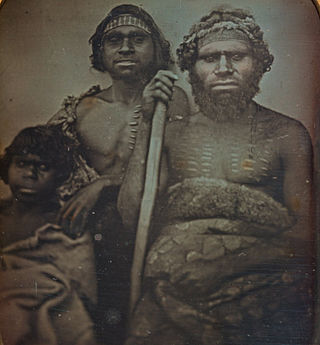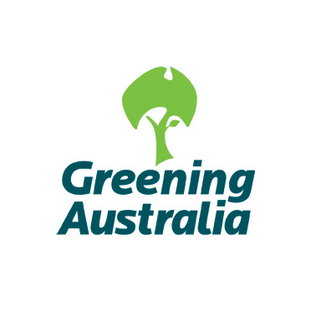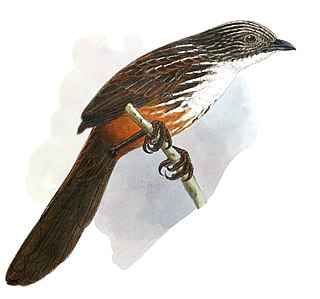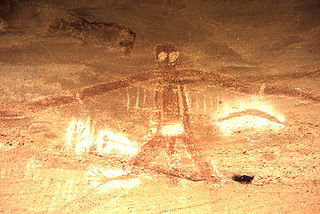
Protected areas of Australia include Commonwealth and off-shore protected areas managed by the Australian government, as well as protected areas within each of the six states of Australia and two self-governing territories, the Australian Capital Territory and the Northern Territory, which are managed by the eight state and territory governments.

Conservation in Australia is an issue of state and federal policy. Australia is one of the most biologically diverse countries in the world, with a large portion of species endemic to Australia. Preserving this wealth of biodiversity is important for future generations. 25% of Australia is managed for conservation.

Koori is a demonym for Aboriginal Australians from a region that approximately corresponds to southern New South Wales and Victoria. The word derives from the Indigenous language Awabakal. For some people and groups, it has been described as a reclaiming of Indigenous language and culture, as opposed to relying on European titles such as "Aboriginal". The term is also used with reference to institutions involving Koori communities and individuals, such as the Koori Court, Koori Radio and Koori Knockout.

Greening Australia is an Australian environmental organisation, founded in 1982, the International Year of the Tree, to protect, restore and conserve Australia's native vegetation. Greening Australia was formed by the United Nations Association of Australia and the Nursery Industry Association of Australia.
Landcare Australia is a community not-for-profit organisation that involves local groups of volunteers repairing the natural environment. Originally, projects focused on agricultural farmland. The idea was that farmers, conservationists, and scientists could work together to improve both farm quality and natural ecosystems.
Formed in 1956, the Australian Speleological Federation Inc. (ASF) is the national body representing those interested in the protection and sustainability of Australia's cave and karst environments. It has approximately 850 members across 28 constituent bodies throughout all Australian states and territories.

The New South Wales Office of Environment and Heritage (OEH), a former division of the Government of New South Wales between April 2011 and July 2019, was responsible for the care and protection of the environment and heritage, which includes the natural environment, Aboriginal country, culture and heritage, and built heritage in New South Wales, Australia. The OEH supported the community, business and government in protecting, strengthening and making the most of a healthy environment and economy within the state. The OEH was part of the Department of Planning and Environment cluster and managed national parks and reserves.

The white-throated grasswren, also known as Yirlinkirrkirr in the local language, is a species of bird in the family Maluridae. It is endemic to northern Australia, found only in West Arnhem Land, in the Northern Territory (NT).

An Australian Aboriginal sacred site is a place deemed significant and meaningful by Aboriginal Australians based on their beliefs. It may include any feature in the landscape, and in coastal areas, these may lie underwater. The site's status is derived from an association with some aspect of social and cultural tradition, which is related to ancestral beings, collectively known as Dreamtime, who created both physical and social aspects of the world. The site may have its access restricted based on gender, clan or other Aboriginal grouping, or other factors.
Australian heritage laws exist at the national (Commonwealth) level, and at each of Australian Capital Territory, New South Wales, Northern Territory, Queensland, South Australia, Tasmania, Victoria, Western Australia state and territory levels. Generally there are separate laws governing Aboriginal cultural heritage and sacred sites, and historical heritage. State laws also allow heritage to be protected through local government regulations, such as planning schemes, as well.
The Australian Heritage Commission (AHC), was the Australian federal government authority established in 1975 by the Australian Heritage Commission Act 1975 as the first body to manage natural and cultural heritage in Australia until its demise in 2004. It was responsible for the creation of the Register of the National Estate.

The New South Wales State Heritage Register, also known as NSW State Heritage Register, is a heritage list of places in the state of New South Wales, Australia, that are protected by New South Wales legislation, generally covered by the Heritage Act 1977 and its 2010 amendments. The register is administered by the Heritage Council of NSW via Heritage NSW, a division of the Government of New South Wales Department of Planning and Environment.
Land councils, also known as Aboriginal land councils, or land and sea councils, are Australian community organisations, generally organised by region, that are commonly formed to represent the Indigenous Australians who occupied their particular region before the arrival of European settlers. They have historically advocated for recognition of traditional land rights, and also for the rights of Indigenous people in other areas such as equal wages and adequate housing. Land councils are self-supporting, and not funded by state or federal taxes.
The Federation of Australian Historical Societies (FAHS) is the peak body for historical societies throughout Australia. It has eight constituent members, one in each of the Australian states and internal self-governing territories. It lobbies governments on behalf of the sector and has formed alliances with other related bodies. It promotes uniform national standards through guides and other publications and fosters historical research, writing and education through fellowships and awards.
National and State Libraries Australia (NSLA), formerly National and State Libraries Australasia, is the peak body that represents the national, state and territory libraries of Australia. The libraries collaborate on and support working groups addressing issues including: copyright issues, archival collections, collection development, marketing, collecting and preserving digital content, collections and services focusing on Indigenous Australians, and other issues relating to the collection, storage and dissemination of the various types of resources held by member institutions. It also compiles annual statistics on public library activities and usage throughout Australia, and publishes statistics on the services of its own collaborating libraries. Precursors to the organisation include the State Librarians Council, the State Libraries Council and Council of Australian State Libraries (CASL).
The Historical Society of the Northern Territory is a historical society founded in Darwin, Australia in 1964. Major objectives of the Society include (1) the study of the history of the Northern Territory of Australia; (2) encouraging the preservation of the Northern Territory's historical relics and records by their deposit with an appropriate national or local authority, but not with the Society ; (3) promoting lectures, discussions, excursions and exhibitions relating to the history of the Northern Territory; and (4) providing an avenue for publishing on the history of the Northern Territory in the Society's journal or as an occasional paper or book.
Annie Forsyth Wyatt was an Australian community worker, conservationist and Red Cross worker. She is celebrated as the driving force behind the establishment of the National Trust movement in Australia, establishing the organisation in 1945 to protect Sydney's historic natural and built sites.
The National Trust of Australia (Victoria) is a community-based, non-government organisation committed to promoting and conserving Australia's indigenous, natural and historic heritage places of cultural significance in Victoria. It was founded in 1956.
National Trust of New South Wales is a membership-based community organisation to "promote the natural, Indigenous and cultural heritage" of New South Wales. It was founded in 1947.
National Trust of the Northern Territory is a membership-based community organisation to "promote the natural, Indigenous and cultural heritage" of the Northern Territory. It was founded in 1976 by Adele Purvis, of Woodgreen Station.








